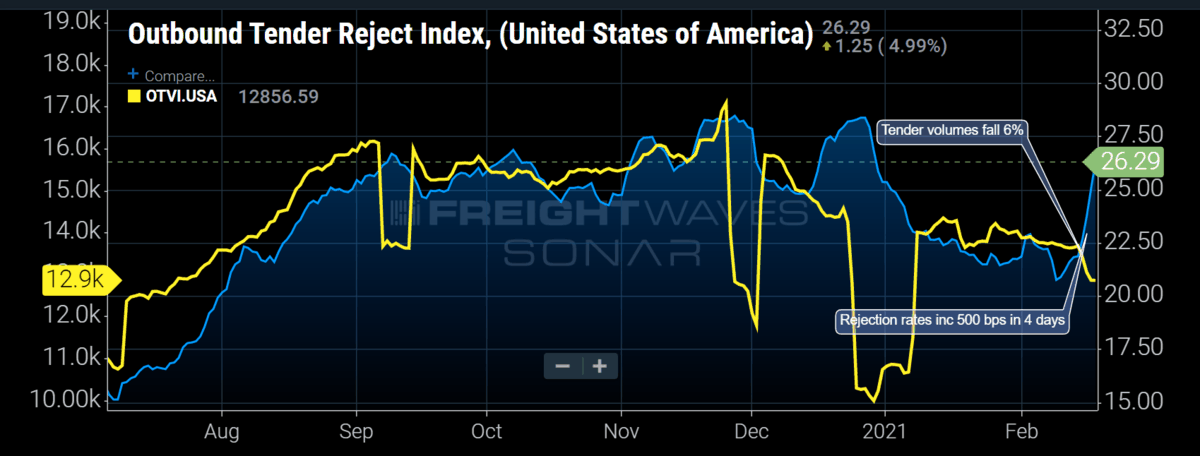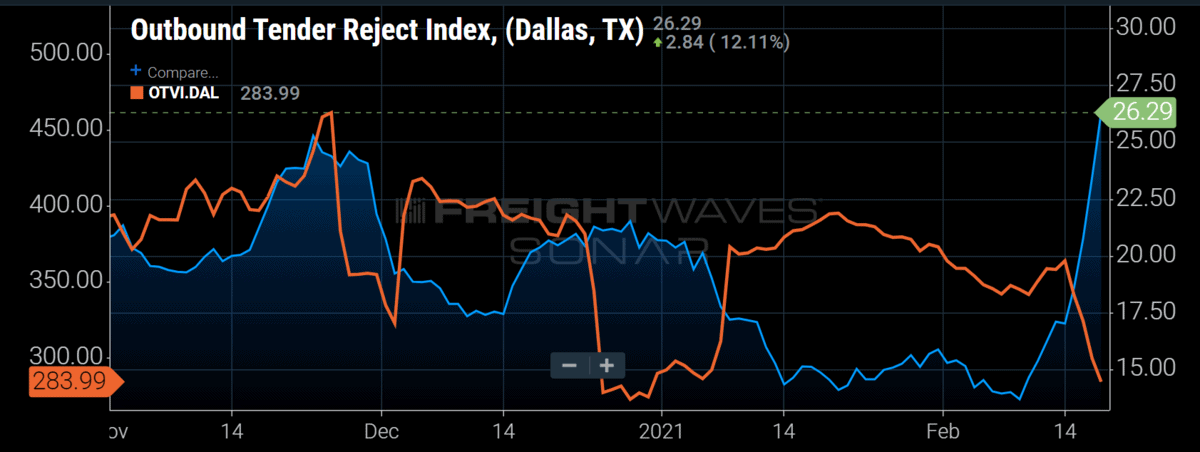
Chart of the Week: Outbound Tender Reject Index, Outbound Tender Volume Index – USA SONAR: OTVI.USA, OTRI.USA
The recent string of winter storms and cold weather that has gripped the central U.S. disrupted shipping across the country in a way that is somewhat counterintuitive — volumes fell while capacity tightened.
The Outbound Tender Volume Index (OTVI) — a measure of shipper requests for truckload capacity — fell over 6% last week while the Outbound Tender Rejection Index (OTRI) — the rate at which these requests are rejected by carriers — jumped to near-peak-season levels in mid-February. Declining carrier compliance is tightly correlated with increasing shipping costs. These events are extending the effects of the shipping boom that resulted from increased consumer demand for goods last year.
Normally, declining demand has the reverse impact on capacity in the way that pressure loosens with lower volumes. It is unusual, but not as rare as one might think, for capacity to tighten and volumes decline simultaneously. This event occurs every year and most often around the Christmas holiday. Though the mechanical reasons are different, the fundamental structure is the exact same between the current situation and the Christmas effect.
The reason is simple: Supply (capacity) falls faster than demand. Most people think supply is relatively constant or slow to change in transportation. This is largely true when measured in aggregate over the course of a year. But certain events greatly reduce the amount of trucks available to haul freight over relatively short periods of time.
Around Christmas, drivers are slowly positioned with loads that put them closer to their homes or vacation spots. This eliminates carriers’ ability to service a wide geography of freight. Simultaneously, shippers outside of the retail space are winding down their activity as they prepare to take time off as well.
Tender rejection rates along with spot rates increase as availability declines and those that do need service are willing to pay for it.
The recent weather-induced capacity crunch events are much different than the slower to develop Christmas effect in the way that they are unexpected and more immediate. In a normal year, winter weather events tend to be relatively short-lived, having little lasting impact. This is not a normal year. Neither was this a standard weather event.
Capacity was recovering slowly prior to the nor’easter dropping feet of snow in parts of freight-dense Pennsylvania and New Jersey — enough to net about a 1.5 percentage point increase in the national OTRI in a two-day period before receding. Tender volumes remained relatively unchanged from their previous course.
The winter storms that pummeled Texas and many other areas not accustomed to regular occurrences of snow and ice had a much bigger impact. Only three states failed to receive measurable snow over the past week. The national OTRI jumped from 20.75% on Feb. 9 to over 26% Thursday — the largest eight-day jump since June. Tender volumes fell 6% from last Sunday to Wednesday.

The fact volumes fell so quickly during this round of storms could portend a rapid return once the weather conditions improve as they are forecast to do this week. Even if capacity returns quickly, volumes could offset this return, pushing the market into further imbalance.
Many companies are already scrambling to restock inventories and keep up with a revitalized consumer. Another round of stimulus was issued and helped push retail sales up in January, which places more pressure on already strained shippers.
The recent weather would probably not have had as significant of an impact in a loose environment in which capacity is abundant, such as the one in 2019. Carriers have underutilized equipment in those markets and can recover loads more effectively.
With tender rejection and spot rates already elevated, the impact has been exaggerated and the recovery will take longer. In this instance, recovery means falling back to the overriding trend of the market before the event, which was slowly loosening with a slow decline in demand.
The nor’easter impact lasted about eight days. If the relationship holds constant, the market will be reeling from the recent weather events until the end of the month — just in time for what is typically a seasonal push of freight. The lesson here is that the current shipping environment remains extremely unstable and more disruptions are likely.
FreightWaves Passport subscribers received a deeper look into the effects of the weather on freight markets this past week. Click here to learn more.
About the Chart of the Week
The FreightWaves Chart of the Week is a chart selection from SONAR that provides an interesting data point to describe the state of the freight markets. A chart is chosen from thousands of potential charts on SONAR to help participants visualize the freight market in real time. Each week a Market Expert will post a chart, along with commentary, live on the front page. After that, the Chart of the Week will be archived on FreightWaves.com for future reference.
SONAR aggregates data from hundreds of sources, presenting the data in charts and maps and providing commentary on what freight market experts want to know about the industry in real time.
The FreightWaves data science and product teams are releasing new data sets each week and enhancing the client experience.
To request a SONAR demo, click here.







